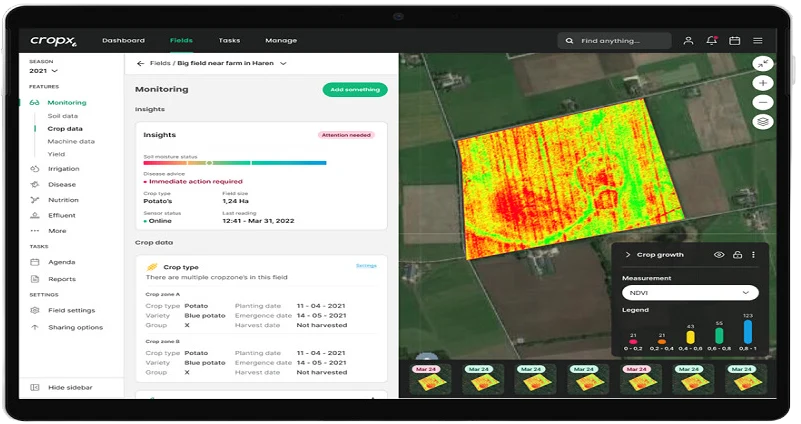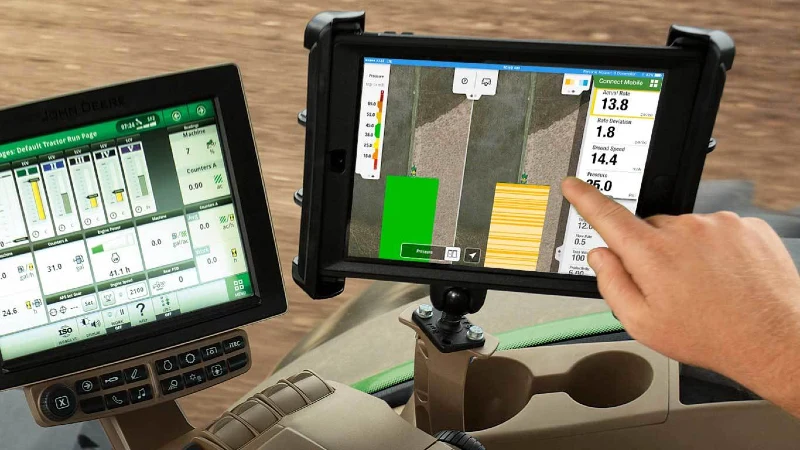US farms are facing a crisis, and they’re urgently turning to artificial intelligence (AI) for help. This technology isn’t just fancy gadgets – it’s becoming vital. Imagine a farmer in the Midwest using a smartphone app to identify a pest on a soybean plant, getting instant information on whether it’s a threat to the crops.
The problem is urgent: a lack of workers is jeopardizing harvests and the industry’s long-term survival. The US is a massive agricultural producer, but an aging workforce and dwindling labor pool put that at risk. Many older farmers struggle with the intense physical demands, and younger generations, including immigrants, are often choosing better-paying, less strenuous jobs.
“Labor is the number one concern,” says Emily Buckman, director of government affairs at the American Farm Bureau Federation. “The average age of a farmer now is 60.” Buckman’s own 70-year-old father still works his Kentucky farm, with limited help.
To address this challenge (and declining crop yields), farmers are embracing robotics and AI. “We think … advances in technology could help ease some of the labor load,” says Buckman.

While AI-powered tools like auto-steering tractors have existed for years, adoption has recently exploded. Around 87% of US agricultural businesses were using AI in some way as of late 2021. Even the federal government is incentivizing the industry to go high-tech.
Why the urgency? If American farms can harness AI, the global impact could be massive. The US is a top food exporter (over $100bn annually!), and with climate change and rising populations, ensuring a steady food supply is crucial.
The goal, as Buckman puts it, is “innovative technology … so that farmers can feed the world.” With the global population set to surge by two billion by 2050, we’ll need to produce 70% more food – and AI could be a key part of the answer.
AI as the Key to Agricultural Resilience
The pressure is mounting on the agriculture industry to find solutions, and time is of the essence. The US labor shortage already forces farms to do more with less, but the climate crisis is pushing things to the breaking point. Unpredictable weather patterns and declining crop yields paint a worrying picture: hotter temperatures could mean a drastic drop in our food supply.
“All projections show major losses in crop yields due to climate change,” says Patrick Schnable, a distinguished professor at Iowa State University. “A 10% or 20% reduction in corn yields would be catastrophic.” The question now becomes: Can AI help us adapt?

Iowa State is leading the charge with the AI Institute for Resilient Agriculture, a collaboration with partners across the US and backed by the National Science Foundation and the USDA. Their focus is two-fold:
- Sustainability: Finding new agricultural practices that can withstand the changing climate.
- Efficiency: Using AI, robotics, and sensors to maximize profits and minimize the waste of precious resources like water and chemicals.
Baskar Ganapathysubramanian, director of the Institute, is optimistic: “There’s a great deal of promise, and some of it’s already being implemented.”
Emily Buckman points to drones and GPS tools as widely used AI solutions. But the possibilities are far more extensive: self-driving tractors, quality sensors that pinpoint areas of a field needing extra attention, and even robots that can take over sorting tasks once done by human workers. AI-powered cultivators are replacing dozens of laborers by planting seeds and intelligently weeding fields.
Farms Fight Back With AI
AI isn’t just about increasing yields – it’s also about doing it sustainably. That’s the idea behind “precision agriculture”, where cutting-edge tools like drones pinpoint exactly where water or pesticides are needed, revolutionizing efficiency.
“Precision agriculture helps reduce water waste, be more efficient, and do more with less,” says Emily Buckman. The result? Advancements in precision agriculture, often powered by AI, have prevented the need for an extra 100 million acres of farmland to produce the same amount of food we do today!
Industry giants like John Deere are at the forefront of this revolution. Their goal, says Sarah Schinckel, Director of Emerging Technologies, is clear: “to help farmers do their jobs better” with AI. These tools aren’t just futuristic visions, they’re changing the game now: “We see a future where more and more farmers are using this technology.”

John Deere’s been an AI pioneer for decades with tools like Autotrac for hands-free steering. But things are accelerating. Their See & Spray tech uses AI to locate weeds with laser-focus, allowing farmers to target herbicides with pinpoint accuracy. This has slashed herbicide use by an impressive 66%, saving money and benefiting the environment. “There’s a clear ROI for a lot of this stuff,” Schinckel explains.
The innovation doesn’t stop there. John Deere’s fully autonomous tractors are a glimpse into the future, where AI handles even more of the workload. Schinckel envisions fully automated farming by 2030: “We have goals… to bring autonomy to all production steps.”
An AI Harvest Is Smarter Farming
It’s not just about the bottom line for farms – AI’s benefits ripple outward in ways that touch us all. “Improved productivity in the fields means… lower prices for consumers,” explains Steven Thomson of USDA’s National Institute of Food and Agriculture. This means more affordable food for families.
The environmental impact is equally crucial. AI-driven tools optimize everything from livestock health to fertilizer use, protecting precious natural resources. As Thomson puts it, “More sustainable practices mean less degradation… and prevention of ecological damage to our planet.”
The US government recognizes this potential, heavily investing in AI research for agriculture. Their goal, says Thomson, is to put “easy-to-use,” AI-powered decision-making tools into farmers’ hands, striking a balance between the environment, economy, and society.
John Deere At CES 2024
The innovations range from the dazzlingly high-tech (think: robots harvesting crops), to surprisingly simple but no less impactful developments. Iowa State’s pest-identifying smartphone app is a perfect example: it saves time, cuts costs, and promotes sustainability. This is vital given the slim margins most farms operate within.
“AI provides a very natural and profitable tool for farmers… to evaluate risks better,” says Patrick Schnable. And the reach extends far beyond any single farm. These tools can be scaled globally, with the potential to boost yields dramatically in areas like Southeast Asia. Since the tech is digital, as Schnable explains, the cost of sharing it is minimal.
While there are challenges ahead, experts see reason for hope. With AI, the agriculture industry could gain much-needed resilience against climate change, labor shortages, and rising costs. The potential is enormous, and with the stakes so high, the urgency has never been greater.
More To Discover
- Revolutionizing Fabric Recycling: New Method From Denmark Could Transform the Clothing Industry
- Farmers Are Shouldering The Burden: The Hidden Cost of Big Food’s Green Push & Every Way It Hits Smaller Farms
- Lab-Grown Seafood: Is The Industry Ready & Would You Eat It?
- The Hidden Giants Behind Vegan Brands Are The Meat And Dairy Industry Heavyweights

What We Covered In This Article
- The labor crisis is real: Aging farmers and a dwindling agricultural workforce threaten crop yields and the long-term viability of farms.
- AI offers solutions: AI-powered tools can automate tasks, optimize resource use, and improve decision-making, easing the labor burden.
- Climate resilience is key: Precision agriculture driven by AI helps farms adapt to unpredictable weather patterns and protect precious resources.
- Benefits extend beyond farms: Increased farm profits, lower food prices, and a healthier environment all result from the intelligent use of AI.
- Government support is crucial: Investments in AI research and development are accelerating innovation in agricultural technology.
- Global impact is possible: The digital nature of AI tools makes them scalable, promising to boost yields and food security in areas that need it most.
The integration of AI into agriculture isn’t about robots replacing farmers, but rather giving them powerful tools to adapt and thrive. Lower costs, healthier ecosystems, and the potential to feed more people in a changing world – these are the promises AI offers.
Time is crucial, and the innovations underway today could shape the way we grow our food for generations to come.




















